What is a Double Tapped Breaker & 3 Ways to Repair Them
A double-tapped breaker occurs when someone attaches more than one wire (conductor) to a breaker. It is generally not allowed and can be a fire hazard under certain conditions.
If you have had a home inspection in the past, say, 300 years, there is a good chance your home inspector wrote something in the electrical section of your report along these lines:
“One (or more) double tapped breakers noted in the electric panel. The inspector recommends further evaluation and proper repair by a licensed electrician.”
A comment in your home inspection report like this one is horrible.
Besides being one of the worst written explanations of a problem I have ever forced my fingers to type, it leaves you, the buyer/homeowner, with little to no information about what the heck is going on here.
Unfortunately, most home inspectors do not take the time to write proper explanations about the problems they discover during an inspection and poorly written comments like the one above will leave the Realtor and buyer scratching their heads about what needs to happen (see example below).
There is also a slew of new, undereducated home inspectors who simply do not know the rules for double-tapped breakers. Below is an image from a home inspector’s report stating the double tapped breakers in this panel need to be corrected for fire safety.
They are half right in that double tapping a breaker can lead to a fire under the right conditions. However, the breakers in the image are Square D, and they are designed to accept two wires. Double tapping a Square D breaker is fine, as long as a few rules are followed. We will cover that later.
This article aims to explain what a double-tap is and how it can be easily corrected. I hope a few new home inspectors take the time to read through this so mistakes like the one below can be avoided.
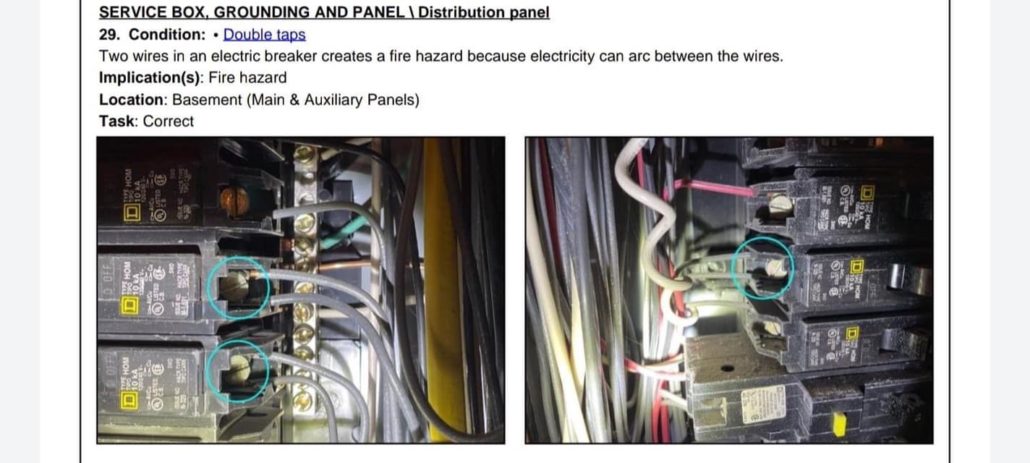
WHAT IS A DOUBLE TAPPED BREAKER?
A double-tapped breaker, more commonly known as a double-tap, is when more than one wire is connected to a breaker (or to a busbar-but we will only talk about breakers for this post) an electric panel. The curveball here is that some breakers are designed to accept multiple wires, and it is not a problem with those types.
Circuit breakers are designed to protect the circuit, not what is connected to them.
In other words, we want to make sure the wires stay in good working order and don’t meltdown and start a fire.
Let’s first look at how to determine how many wires a breaker will accept, and then we will look into how to fix the problem if you have too many connections on a breaker. This, of course, is known as a double tap or even a triple tap if you have an extra stupid person working inside your electric panel.

WHY ARE DOUBLE TAPPED BREAKERS A PROBLEM?
It’s all about the connection between the wire and the breaker. If more than one wire is connected to the breaker, and that breaker is not designed for two wires, the chances of those connections being too loose is much greater than those with just one wire connected.
If the connection between a breaker and a wire becomes loose, it could cause overheating or, worse, start to arc between the gaps. Arcing is what starts a fire in an electrical panel. Making sure your breakers’ connections are tight and properly executed is very important to fire safety.
The issue with double-tapping a breaker has nothing to do with the load (demand) on the circuit. I see a lot of bad info floating around saying that more than one connection on the breakers can cause an overload on that breaker. That is 100% false.
SOME DOUBLE TAPPED BREAKERS ARE NOT A PROBLEM
As if the rules aren’t confusing enough, sometimes you can double tap breakers and it’s not a problem. There are a couple of manufacturers that rate and allow certain breakers to have these types of connections made to them.
So how do you know which is which? It’s printed on the breaker.
As far as I know, some Square D’s and some Cutler Hammer breakers are OK to double tap, but everything else is a no-no. If you know of another brand where this practice is acceptable, please let me know and I’ll add it to the list.
Note: Notice that both of these breakers state that you should not double tap the connections if an aluminum wire is involved. When aluminum (AL) wire is present, it is stated that you are only allowed a single connection. Homes with aluminum wire have a whole different set of rules that you can learn more about here- Aluminum wiring in homes.
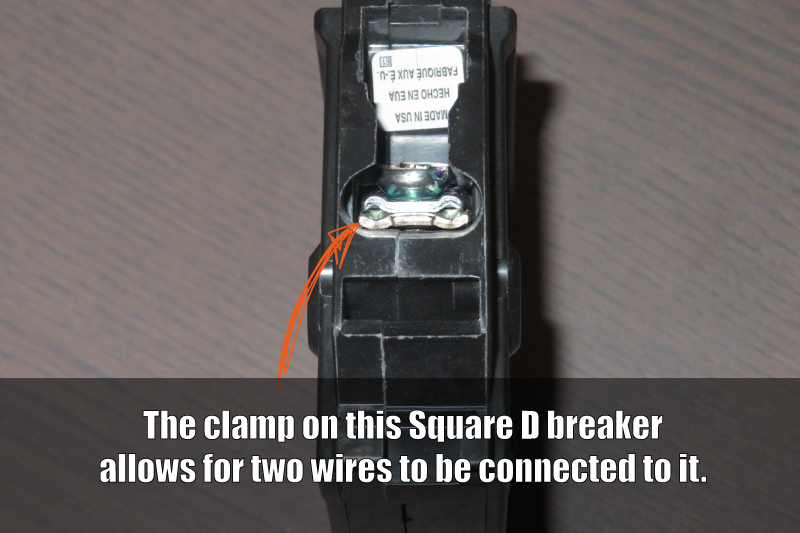
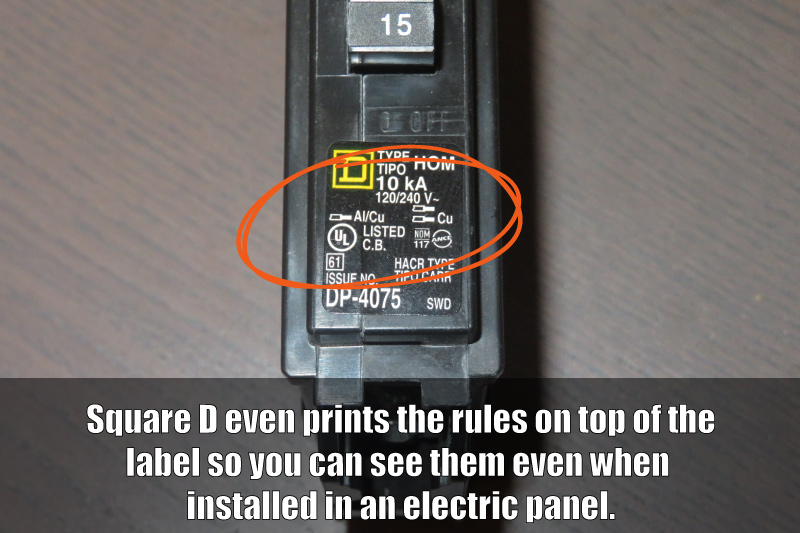
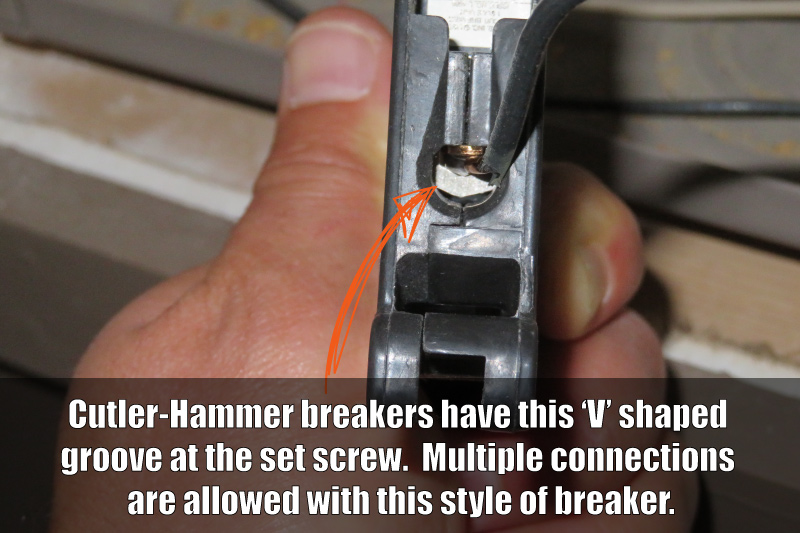
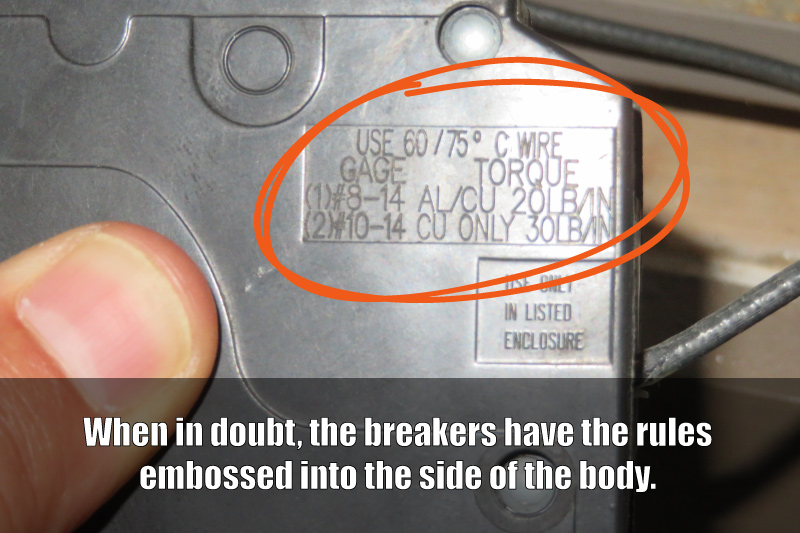
HOW TO REPAIR A DOUBLE TAPPED BREAKER
Now that you know how to determine what a double tapped breaker is, let’s explore the options on how to correct them. These are all fairly simple, but if you don’t have past experience or knowledge with working inside an electric panel, it would be best to call in a pro. There are points inside these panels that can kill you in the blink of an eye, even if you turn off the main breaker.
PIG TAIL THE WIRES
This is by far the simplest solution, and to be honest, I don’t know why you would ever bother with any other repair when dealing with a double-tapped breaker. All you need is a small section of wire and a wire nut. Simply twist all 3 wires together and only connect the single wire back to the breaker. All done. Everything connected to this breaker is still limited to the breaker size itself in terms of amperage protection, and if you pre-twist the wires together before you cap them off with a wire nut, you’ll be good to go.

INSTALL A TANDEM BREAKER
If you need control over whatever each wire is connected to via a breaker handle, you can get tandem breakers for most modern electric panels.
These breakers allow for two single pole arms to be installed in a single-width slot in the electric panel. You just need to make sure you are installing them in a spot they are allowed. All panels should have a diagram on the door that tells you which breaker is allowed in what spot. Some allow tandems all over; some older panels don’t allow them at all. Every brand is different so you’ll need to check yours to know for sure.
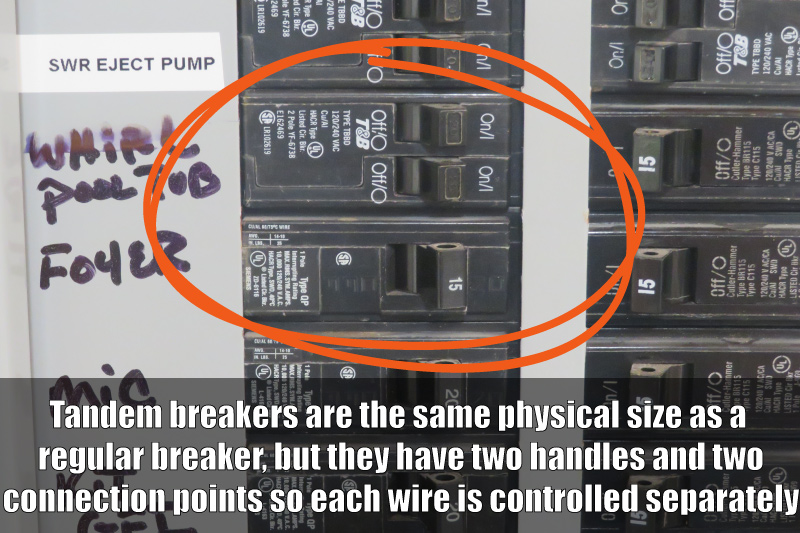
ADD A BREAKER
If you have the room in your panel, you could always go the traditional route and install a new single pole breaker in an open slot. Single breakers are cheap (under $5), and this is the simplest repair in terms of technical skill. If you can turn a screwdriver, you can install a breaker.
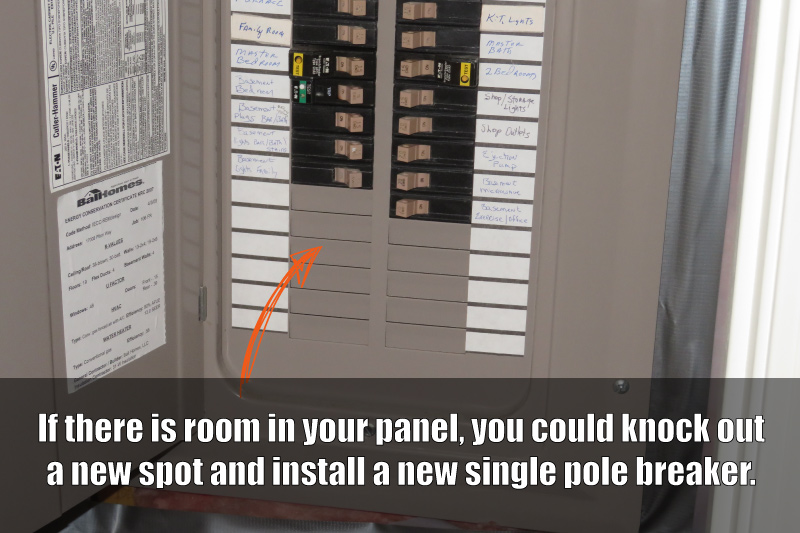
INSTALL A NEW ELECTRIC PANEL
The vast majority of the time, one of the options above will take care of your double-tapped breaker woes. If you find yourself in a situation where it won’t, sometimes a larger panelboard may need- but those times are few and far between. Only your electrician can tell you for sure when it comes to needing a replacement panel.
For all the young and budding home inspectors out there who happen to read this, please feel free to steal my wording that I use for my home inspection reports about double tapped breakers. Don’t be that guy who writes crap like I have at the top of this post and call it an “explanation.” Be detailed. Be descriptive.
“The panelboard has (insert number of double taps) double tapped breakers located (insert location of said breakers).
Double tapped breakers are an unsafe condition in which multiple conductors are placed under the set screw of a single breaker.
When multiple wires are connected to a breaker, you greatly increase the risk of a loose connection, which can lead to overheating, arcing, and electrical fires. It’s typically a fairly simple repair so be sure to have an electrician evaluate the situation and correct things as needed.”


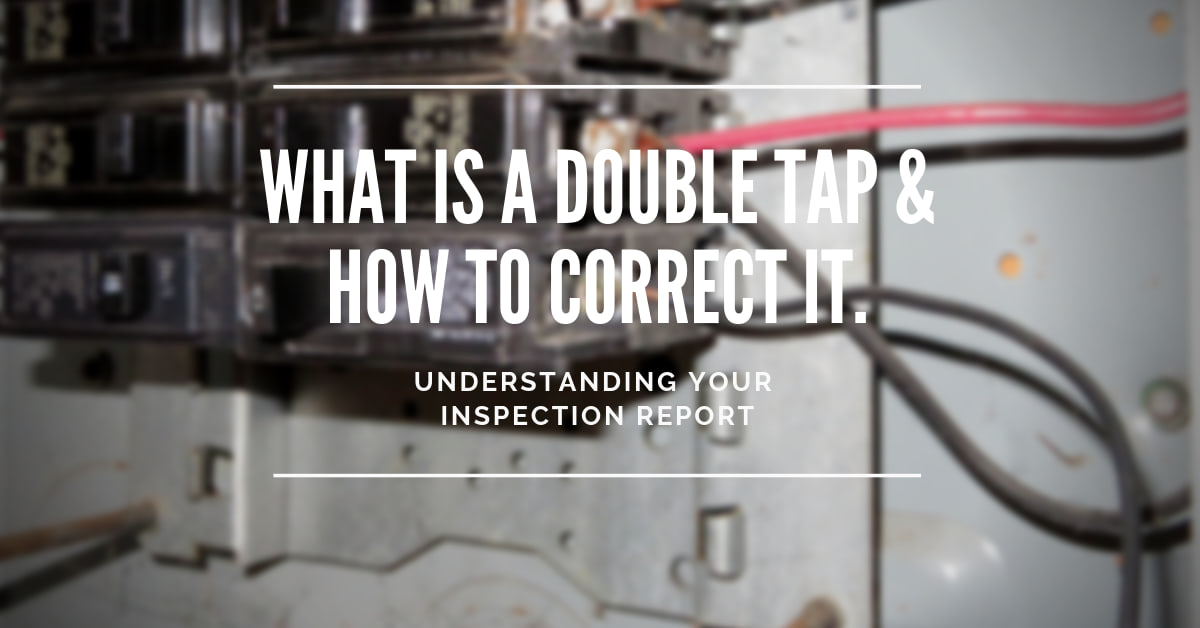

Thanks for this. My home inspector wrote in my inspection report that I had several double-tapped breakers but offered no help in what that meant or how to properly repair them.
Thanks, Greg. I know it can be frustrating when your home inspection report doesn’t give you enough detailed information about the issues. Let me know if I can help in any way.
My buyer has been trying to scare me into buying them a new service panel.
After reading your article I think I’d like to sell my home to someone with a little more integrity !
Thanks
Hi Christain – I’m sorry to hear you are dealing with someone like that. Good luck with everything!
Thanks, for all the information posted, very helpful and simplified.
Thank you, Michael. Let me know if I can help in any way.
As a electrical contractor, I get a lot of inspection reports from realtors. This one always amazes me. You my friend are one of the few who know what different breakers can have up to 2 wires. Most flag as a “double tapped” and most in my area are square D QO. Keep up the good work. Maybe we can discuss the difference between rubber/cloth insulated and cloth sheathed NM. Big difference. Thanks
Thanks, John. I too see my fair share of guys who simply do not know what they are doing. Here’s to hoping they continue to hone their skills and get past these simple ones.
As a electrical contractor, I get a lot of inspection reports from realtors. This one always amazes me. You my friend are one of the few who know what different breakers can have up to 2 wires. Most flag as a “double tapped” and most in my area are square D QO. Keep up the good work. Maybe we can discuss the difference between rubber/cloth insulated and cloth sheathed NM. Big difference. Thanks
Thanks, John. I too see my fair share of guys who simply do not know what they are doing. Here’s to hoping they continue to hone their skills and get past these simple ones.
Hey John,
I’m selling my rental house to the renter. Her inspector found a double tap. This was installed by the builder back in 1999. I purchased in 08 as an investment. Where do I look on breaker to see if its allowable?
Thanks
John
I’d first look at the brand of the panel. If it is not a Square-D or Cutler Hammer odds are it is not allowed. If it one of those two you’ll need to check the top or side of the breaker as it’s typically embossed on the body of the breaker. If you are not experienced in electrical work it would be in your best interest to have an electrician just fix the problem and move on. It shouldn’t be a big problem at all.
Hi Ben,
Would a double tap on the main service breaker, with no room left in the panel be a situation where a larger panel would be the answer? Currently the panel has 20 spaces and all are filled. The main was tapped to install a sub breaker for an AC unit.
Some are allowed to be double-lugged, most are not. You’ll have to check your panel to know for sure. The ones I’ve seen that are allowed have a ‘double hole’ like the number 8 at the main lug so both cables can fit securely.
Thanks for preparing me to ask the right questions when the electrician comes to fix one double-tapped breaker. The inspector passed it and said it isn’t dangerous but asked me to be sure and get it fixed. The home is a 1976 double-wide and I believe the panel is original. It was also suggested I contact the fire dept. to get a “free” smoke alarm installed which is also original. Unfortunately, I’ve been since told they will make me bring my home up to code, ca-ching! I’m on Soc. Sec. and would not have called if I had known. I’m going to save your website to faves. Thanks!
Hi Diane,
I’m sorry to hear about your troubles. Please let me know if I can help in any way.
So helpful. I have a circuit with a 240v baseboard heater (used lightly during the winter) and I want to add an outlet to run my compressor (which will 95% be used during the months the baseboard heat will not be used) and I have just such a breaker that allows double tap. This clears things up!
Great Post!!
Ben – great post – I too am a home inspector with over 10 years of experience. I am in Florida and we have what is called a 4-Point (Insurance Report – Plumbing/HVAC/ROOF/Electrical) – so with home inspections and 4-point I have completed over 10,000 reports.
While I absolutely agree with your article I have been finding that CITIZENS Insurance (the last ditch insurers and providers for most older homes in FL) will not cover a home with double taps – period. It does not matter to them who put it in (can actually be the utility company) or what they are for (ex: spark arrestors) – and what the manufacturer of the panel or breaker says – they simply will not allow it.
It is very frustrating for us home inspectors because the local electrician (not knowing the insurance side of things) get all upset with us home inspectors – saying that the home inspector doesn’t know what they are talking about (and my specific reports says that I know that it is common practice but to “check with your insurance provider first”). And yes, I do put the repair (preferring the pig-tail) in my reports. Sellers don’t want to pay for it – insurers don’t want to insure it – and local electricians don’t want to do small jobs! So we home inspectors get to hear it from everyone – and the poor realtors are stuck in the middle of it all.
Hi…
I need a little advice… I am in the process of buying a house and the house inspector found the main breaker in the primary 200 amp panel has been double tapped during a renovation process. This is a 1949 house that was completely renovated (and rewired) over 15 years, finally complete in 2018. The latest owners have done some additional work and it’s possible this is when the double tapping took place.
There are 2 smaller 100 amp sub panels and I can only assume that one of these is what is double tapped to the main panel. There are 2 VERY large wires plugged into the Eaton CSR2200N 200 amp main breaker. The issue is the sellers refuse to let us get the issue examined by a qualified electrician so we can price out the fix, assuming it’s necessary.
They’ve told us their “brother in law”, a contractor, says it OK and that’s good enough for them… I’d just like confirmation that this is not how this is supposed to be and it’s not an unreasonable request. I’d read that there are double tapping lugs, but the panel has to support them so if the panel would support them (unlikely) would the double lugs solve the problem? THANKS!!!
Hi Sharon – There are some lugs that allow for more than cable, but most do not. Without being able to see the panel in question there is no way to know. It sounds like you are dealing with an unreasonable seller. Hopefully they will allow you to have someone look at it. Good luck with everything!
Thank you so much for explaining “double tapping”. My electrician double tapped two out let circuits and they keep popping the breaker. I have plenty of open spaces, so not sure why he did that, but putting another breaker is going to work for me.
Thanks again!
Happy to help Gregg.
I greatly appreciate the information in this article. I am a first time home buyer currently researching double tapping breakers. The home inspection report literally states “breakers with double tapping need to be reviewed and repaired by a qualified contractor.” I had no idea what those words meant other than i needed an electrician. This article explains so much that the inspection report did not. I appreciate the knowledge given in this article. Thank you!
Thanks, Chistina. That is very kind of you. I agree that home inspectors could do a better job of explaining things!
Ben- your article is well written and informative. Thank you for moving beyond the high-level “double-tapped breaker is BAD”, to more details, with pictures about ‘how’ and ‘what’ is a problem AND what is not. Thank you.
Thanks, Mike. Very kind of you.
Hey Ben
I just wanted to thank you for a excellent explanation of a double tap. Your explanation was clear and very informative.
No worries at all. I’m glad I could help.
Ben, Great outline on “Double Tapped” breakers.
That was on my home inspection report too.
Turns out my breakers are fine but there could be double tapping on the grounding bar.
Can you comment on that?
The grounds (bare copper) can be doubled; the neutrals (whites) are not. However, there are rules for the wire size and how many can be tied together. You can research more about the grounds here: NEC Section 408.41